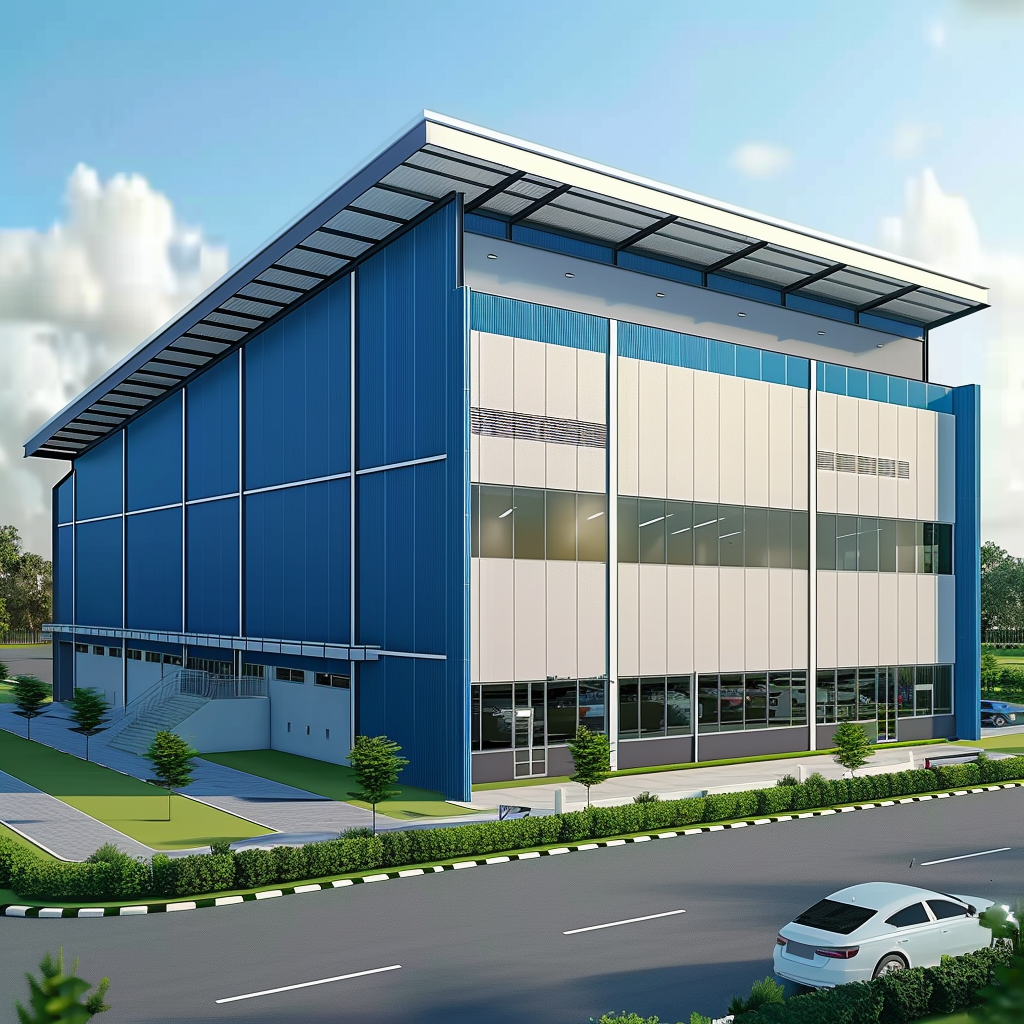Exploring The Versatility And Advantages Of Steel Structure

Exploring The Versatility And Advantages Of Steel Structure
In the dynamic world of construction, steel structure stands as a beacon of innovation and efficiency. Its unparalleled strength, durability, and versatility have revolutionized the way we build, offering architects, engineers, and builders endless possibilities for creating structures that are both functional and aesthetically pleasing. In this comprehensive blog post, we'll delve into the fascinating world of steel structure, exploring its history, evolution, and the myriad advantages it brings to modern construction projects.
A Brief History of Steel Structure:
The use of steel in construction dates back centuries, with early examples found in ancient civilizations such as the Romans and Chinese. However, it wasn't until the Industrial Revolution that steel emerged as a dominant building material, thanks to advancements in manufacturing and production techniques. The advent of steel mills and the Bessemer process in the 19th century paved the way for mass-produced steel, making it more accessible and affordable for construction purposes. Since then, steel structure has continued to evolve, with new technologies and engineering innovations pushing the boundaries of what is possible in building design.
The Advantages of Steel Structure:
Steel structure offers a multitude of advantages that have cemented its position as a preferred building material in modern construction projects:
Strength and Durability: One of the most notable advantages of steel structure is its exceptional strength-to-weight ratio. Steel is inherently strong and durable, capable of withstanding extreme loads, including heavy snow, high winds, earthquakes, and even fire. This strength allows for the construction of tall, slender buildings and bridges that would be impractical or impossible with other materials.
Versatility and Flexibility: Steel structure offers architects and designers unparalleled versatility and flexibility in their designs. Its inherent properties allow for long spans, open floor plans, and innovative architectural forms, enabling the realization of bold and visionary concepts. From soaring skyscrapers and iconic landmarks to sleek, modern residences and industrial facilities, steel structure can adapt to a wide range of aesthetic and functional requirements.
Speed of Construction: Compared to traditional building materials like concrete and masonry, steel structure offers significant advantages in terms of construction speed and efficiency. Prefabricated steel components can be manufactured off-site and assembled quickly on-site, reducing construction timelines and minimizing disruptions to surrounding areas. This accelerated construction process translates to cost savings and faster occupancy, making steel structure an attractive option for developers and investors.
Sustainability and Environmental Benefits: Steel is a highly sustainable building material, with a high recycling rate and low environmental impact compared to other materials. The recyclability of steel makes it a preferred choice for green building projects, reducing waste and conserving natural resources. Additionally, steel structures are energy-efficient, with the ability to incorporate features such as insulation, solar panels, and passive design strategies to minimize energy consumption and carbon emissions.
Cost-Effectiveness: While the initial cost of steel structure may be higher than some traditional building materials, its long-term benefits far outweigh the upfront investment. Steel structures are durable, low-maintenance, and resistant to corrosion, reducing lifecycle costs and minimizing the need for repairs and replacements. Additionally, the speed of construction and flexibility of design associated with steel structure can result in overall cost savings, making it a cost-effective choice for a wide range of construction projects.
Applications of Steel Structure:
Steel structure finds applications across a diverse range of industries and sectors, including:
Commercial and Residential Buildings: From office towers and shopping centers to apartment complexes and single-family homes, steel structure offers a versatile and cost-effective solution for building construction. Its strength, durability, and flexibility make it well-suited to a wide range of architectural styles and design requirements.
Industrial Facilities: Steel structure is widely used in the construction of industrial facilities such as warehouses, factories, and distribution centers. Its ability to accommodate large clear spans and heavy loads makes it ideal for housing machinery, equipment, and inventory, while its durability and resistance to fire and pests provide long-term reliability and security.
Infrastructure and Transportation: Steel structure plays a critical role in infrastructure projects such as bridges, highways, and transit systems. Its high strength and durability make it well-suited to supporting heavy traffic loads and withstanding harsh environmental conditions, ensuring the safety and longevity of vital transportation networks.
Institutional and Public Buildings: Steel structure is often used in the construction of institutional and public buildings such as schools, hospitals, and government facilities. Its speed of construction and adaptability to various design requirements make it an attractive option for projects with tight schedules and budget constraints, while its durability and resilience provide a safe and secure environment for occupants.
Conclusion:
Steel structure stands as a testament to human ingenuity and innovation, offering unparalleled strength, durability, and versatility in modern construction. From towering skyscrapers and sleek residences to industrial facilities and iconic landmarks, steel structure has reshaped the skyline of cities around the world, leaving an indelible mark on the built environment. As we continue to push the boundaries of architectural design and engineering excellence, steel structure will undoubtedly remain at the forefront of innovation, driving the evolution of construction for generations to come.
As we continue to explore the possibilities of steel structure, ongoing advancements in technology and engineering are poised to further enhance its capabilities and expand its applications. Emerging trends such as Building Information Modeling (BIM), digital fabrication, and advanced materials are revolutionizing the way steel structures are designed, fabricated, and constructed, enabling greater efficiency, precision, and sustainability in the building process.
In addition to its traditional strengths, steel structure is increasingly being recognized for its resilience and adaptability in the face of evolving challenges such as climate change, urbanization, and demographic shifts. As cities grow and populations increase, the demand for resilient, sustainable, and cost-effective building solutions will only continue to rise, further driving the adoption of steel structure in construction projects worldwide.
Moreover, steel structure has the potential to play a pivotal role in addressing pressing global challenges such as housing affordability, disaster resilience, and environmental sustainability. By leveraging its inherent strengths and embracing innovative approaches to design and construction, steel structure can help create a more resilient, equitable, and sustainable built environment for future generations.
In conclusion, steel structure represents a cornerstone of modern construction, offering unparalleled strength, durability, and versatility in building design and construction. From towering skyscrapers to humble residential homes, steel structure has left an indelible mark on the built environment, reshaping skylines and redefining the possibilities of architectural expression. As we look to the future, steel structure will continue to be at the forefront of innovation, driving the evolution of construction and shaping the world we live in for generations to come.
In summary, steel structure stands as a testament to human ingenuity and innovation, offering unparalleled strength, durability, and versatility in modern construction. Its history, evolution, and myriad advantages have cemented its position as a preferred building material for architects, engineers, and builders worldwide. From its humble beginnings in ancient civilizations to its current role as a cornerstone of modern construction, steel structure has reshaped the built environment and transformed the way we live, work, and play.
As we continue to push the boundaries of architectural design and engineering excellence, steel structure will undoubtedly remain at the forefront of innovation, driving the evolution of construction for generations to come. With ongoing advancements in technology, materials, and construction techniques, the potential of steel structure to create resilient, sustainable, and cost-effective buildings is greater than ever before. By embracing the versatility and advantages of steel structure, we can create a built environment that meets the needs of today while safeguarding the future for generations to come.
Additionally, the widespread adoption of steel structure is not limited to developed countries but is also increasingly prevalent in emerging economies where rapid urbanization and infrastructure development are driving demand for durable and efficient construction solutions. By leveraging the advantages of steel structure, these countries can accelerate their development efforts while minimizing environmental impact and maximizing resource efficiency.
Furthermore, the versatility and adaptability of steel structure make it well-suited to address evolving trends and challenges in the construction industry. For example, the rise of sustainable design and green building practices has led to increased interest in steel structures for their recyclability, energy efficiency, and ability to accommodate renewable energy systems such as solar panels and wind turbines.
In the face of growing concerns about climate change and natural disasters, steel structure offers resilience and durability, making it an ideal choice for buildings in high-risk areas prone to earthquakes, hurricanes, and other extreme weather events. Its inherent strength and ductility allow steel structures to withstand significant loads and deform without collapsing, providing a critical lifeline in times of crisis.
As we look ahead to the future, the role of steel structure in construction will only continue to expand and evolve. With ongoing advancements in technology, materials, and construction methods, steel structure has the potential to drive innovation, improve efficiency, and create sustainable and resilient built environments that enhance the quality of life for people around the world.
In conclusion, steel structure stands as a symbol of progress and possibility in modern construction, offering strength, durability, and versatility unmatched by other building materials. Its widespread adoption and continued evolution underscore its importance in shaping the built environment and meeting the challenges of the 21st century. As we embrace the advantages of steel structure and harness its potential for innovation, we can create a future where buildings are not just structures but symbols of resilience, sustainability, and human ingenuity.
In summary, the evolution and widespread adoption of steel structure have transformed the construction industry, enabling architects, engineers, and builders to realize ambitious designs and create buildings that are stronger, safer, and more sustainable. From its ancient origins to its modern-day applications, steel structure has played a pivotal role in shaping the built environment and advancing human civilization.
Looking ahead, the future of steel structure is bright, with ongoing advancements in technology, materials, and design pushing the boundaries of what is possible in construction. As we continue to explore innovative approaches to building design and construction, steel structure will remain at the forefront of innovation, driving progress and shaping the world we live in for generations to come.
Whether used in towering skyscrapers, iconic landmarks, or humble residential homes, steel structure will continue to stand as a symbol of human ingenuity, resilience, and progress. Its versatility, durability, and sustainability make it an indispensable building material for the 21st century and beyond, ensuring that the legacy of steel structure will endure for centuries to come.
In conclusion, steel structure represents a cornerstone of modern construction, offering unparalleled strength, durability, and versatility in building design and construction. From its ancient origins to its modern-day applications, steel structure has revolutionized the way we build, enabling architects, engineers, and builders to realize ambitious designs and create buildings that are stronger, safer, and more sustainable.
The evolution of steel structure has been driven by advancements in technology, materials, and design, pushing the boundaries of what is possible in construction. Today, steel structures can be found in a diverse range of applications, from towering skyscrapers and iconic landmarks to industrial facilities and residential homes.
Looking ahead, the future of steel structure is bright, with ongoing innovations poised to further enhance its capabilities and expand its applications. As we continue to explore new approaches to building design and construction, steel structure will remain at the forefront of innovation, driving progress and shaping the world we live in for generations to come.
Ultimately, steel structure stands as a testament to human ingenuity, resilience, and progress. Its versatility, durability, and sustainability make it an indispensable building material for the 21st century and beyond, ensuring that the legacy of steel structure will endure for centuries to come.
Steel structure refers to a framework made primarily of steel components, commonly used in construction for buildings, bridges, and other infrastructure. Its strength, durability, and versatility make it a popular choice for various applications, offering advantages such as cost-effectiveness, rapid construction, and resistance to fire and pests.




